WHO HEALTH SECURITY PREPAREDNESS (HSP)
DEPARTMENT
2022: Achievements & Impact

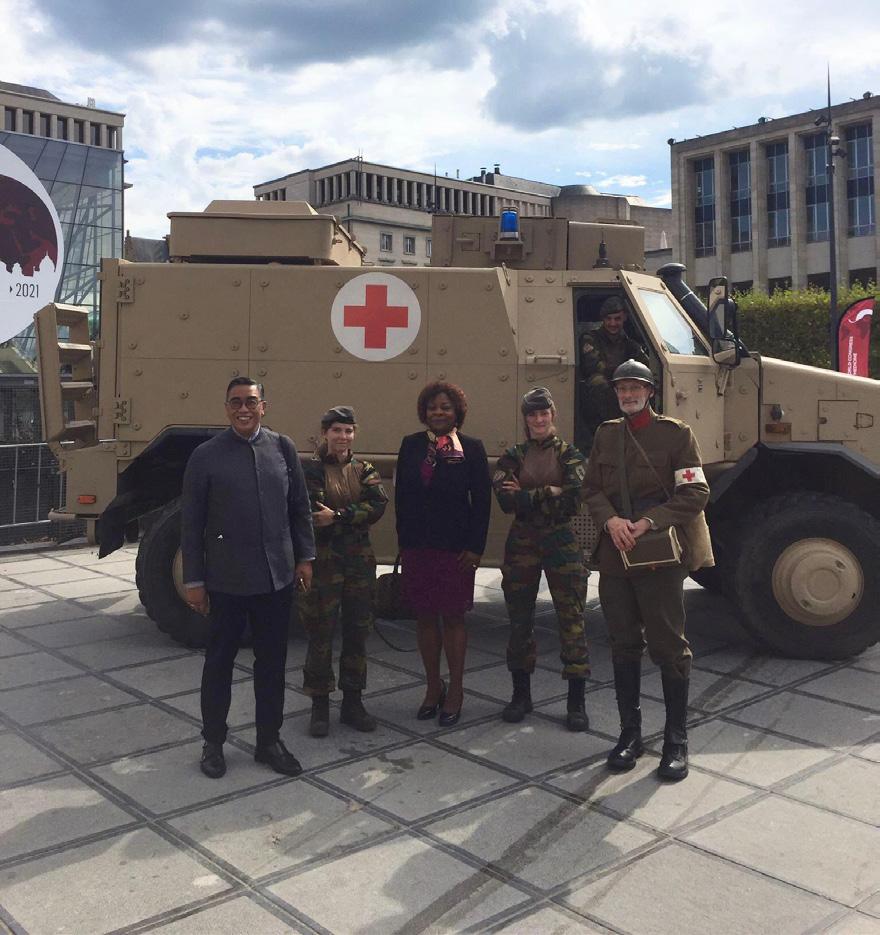
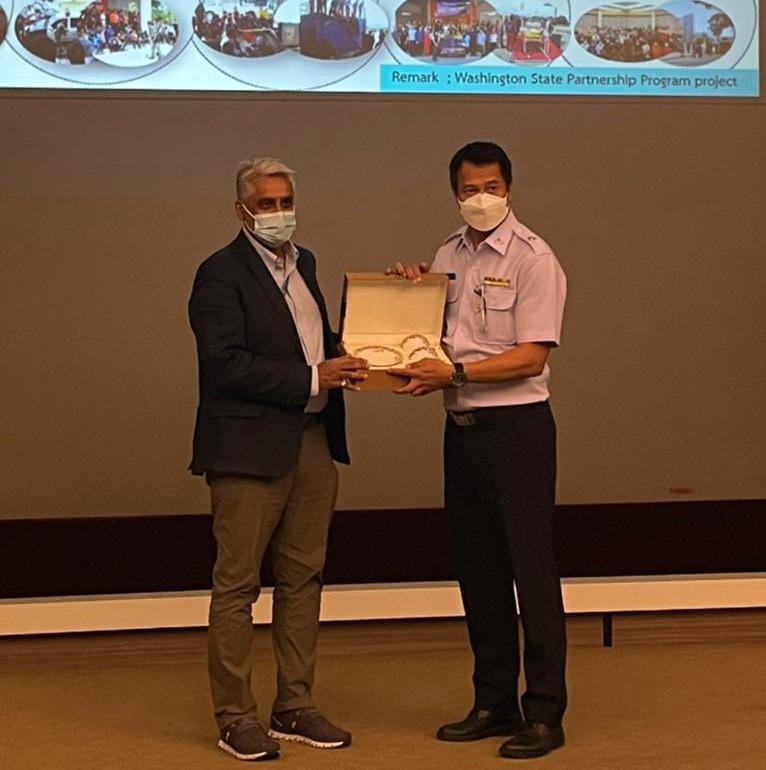
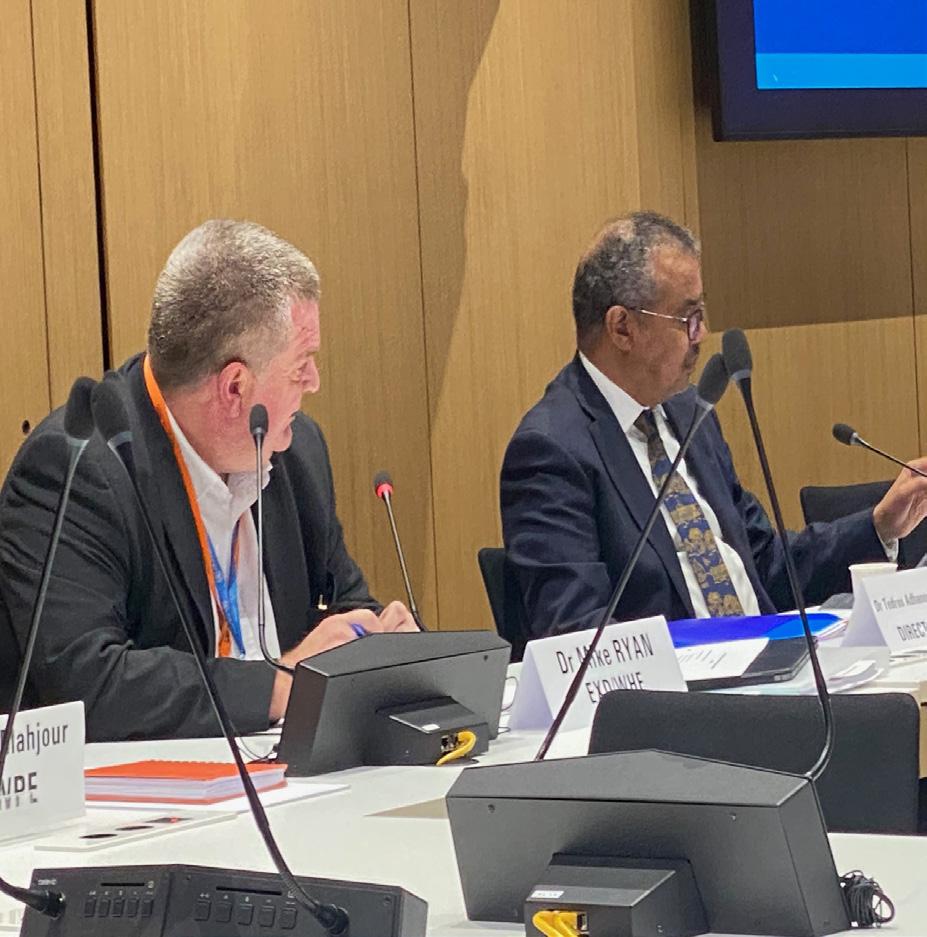
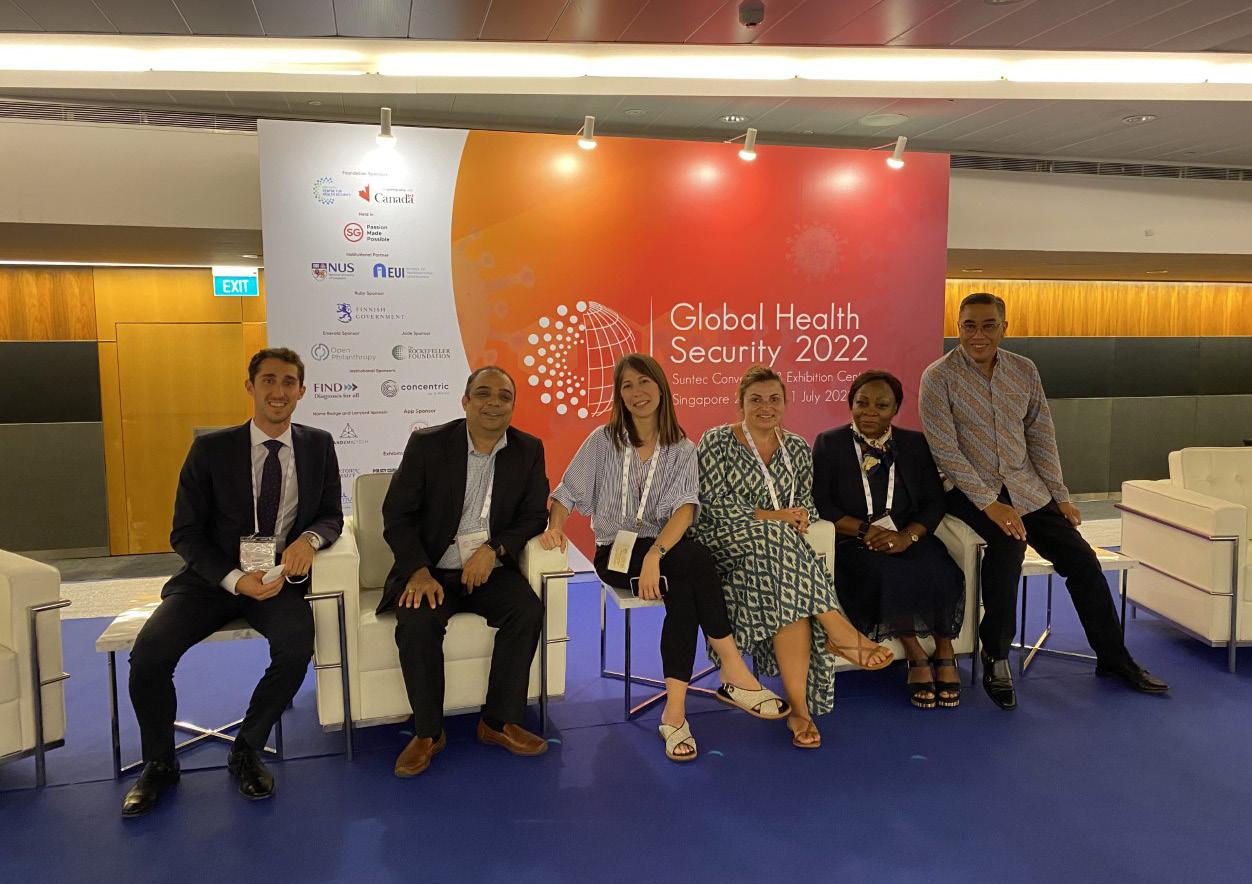







Dr. Stella Chungong
The report highlights the work of the Health Security Preparedness department in a year full of achievements and opportunities. It underlines our commitment to sharing the visibility of our work on evidence-based health security preparedness information and actions for better-prepared countries. In this publication, you will read about our progress and impact in supporting Member States’ health security capacity to detect, prevent and respond to health emergencies in 2022.
This document provides an overview of our journey to support countries in strengthening their health emergency preparedness capacities and health systems. This year has been a moment of reflection and action on the lessons from the COVID-19
Pandemic and other health emergencies and how various stakeholders came together to strengthen the global health architecture for health emergency preparedness and response, with a stronger World Health Organization (WHO) at its centre.
While not exhaustive, this publication covers a wide range of efforts against a backdrop of recovery from the impact of the COVID-19 pandemic alongside multiple global health, humanitarian, and security crises.
WHO Member States started drafting and negotiating through the Intergovernmental Negotiating Body (INB), a legally binding instrument to strengthen pandemic prevention, preparedness, and response.
In parallel, the working group on International Health Regulations is reviewing targeted amendments to the International Health Regulations (IHR) (2005). A new Pandemic Fund was launched in collaboration with the World Bank.
Ongoing outbreaks such as Ebola, Cholera, Lassa Fever, Marburg, and mpox collectively make a case for the dire need to strengthen global health security and our role, working in partnership with relevant stakeholders, to bolster the capacities of countries to detect, respond and prevent such pandemics. Undoubtedly, this will require resources and sustained high-level political will, equity, and solidarity, which are key elements for a multi-pronged and whole-ofsociety approach to global health security.
To this end, working closely with the WHO regions and partners, existing assessment mechanisms for health emergency preparedness have been revised and
updated based on the experiences and lessons from COVID-19, other health emergencies and hundreds of recommendations from various governing bodies, institutions and committees.
These include the third edition of the Joint External Evaluations (JEEs) and the main changes to it along with the capacities and indicators to be evaluated; the new National Action Plans for Health Security (NAPHS) strategy, which addresses identified gaps and challenges at the country level; the newly launched Universal Health and Preparedness Review (UHPR) mechanism to promote regular intergovernmental dialogue as well as mutual trust and accountability between Member States; the Dynamic Preparedness Metric and IHR Benchmarks further scoped out and aligned with revised IHR MEF tools; National Bridging Workshops and other tools under the Tripartite Zoonoses Guide; the developed online platform to guide countries through the pathway to improved health security at the human-animal interface; the Urban preparedness, multisectoral framework and work with parliamentarians and military actors; Simulation Exercises supporting ever wider partners
and Intra and After Actions Reviews and the work of the Gender Working Group and new gender mainstreaming strategy that provides the necessary guidance to address the specific gender-based needs.
We continuously strive to provide the necessary support and technical guidance to improve preparedness capacities, protect vulnerable communities and keep communities safe from the devastating effects of health emergencies.
We look forward to continuing working with all our partners to ensure that the lessons of the past three years are harnessed to drive into a new era of pandemic preparedness, readiness and response.
As we address the fundamental challenges of this pandemic, we must also continue to address the fundamental weaknesses in global pandemic preparedness, readiness and response so that we can face the future together with hope.
The Health Security Preparedness Department is dedicated to assisting Member States in enhancing their capacities for health emergency preparedness under the International Health Regulations (2005) and beyond. This support is provided in a comprehensive, inclusive, and sustainable manner, with the overarching goal of safeguarding communities and mitigating the detrimental impacts that health emergencies can inflict on our society.
The department’s primary objective is to promote the adoption of evidencebased information and strategies among countries, thus facilitating their readiness for effective responses to health crises.

Figure 1: These are countries where working with our regional counterparts, the department has provided direct health security preparedness support and engagement. For specific details of the events, see pages 15-18.
One of the main objectives of the HSP Department is to support Member States to routinely assess and test the preparedness capacities in all countries and regions through IHR M&E and other complementary tools.
This voluntary, collaborative, multi-sectoral process assesses Member States' capacities to prevent, detect and rapidly respond to public health emergencies. As of December 14, 2022, 117 countries have completed a JEE, and so far, an additional 11 countries are planning to undergo a JEE in 2023.
In 2022, Thailand became the first country to conduct a second JEE and the first to use the JEE 3rd Edition. In 2021, a consultative meeting reviewed lessons from the COVID-19 pandemic and made recommendations for improvement of the JEE, eventually developing the third edition of the tool. JEE results are published online, enabling partner organizations to work with countries more closely to address health security gaps.
Following a JEE, countries are encouraged to develop a National Action Plan for Health Security (NAPHS) with an accompanying budget to address gaps in health security and identify resources required to address those gaps.
Approximately 74 countries have made substantial progress in developing NAPHS. Through WHO-organized working groups, countries and partners revised the JEE and SPAR to improve consistency between the JEE and SPAR; emphasize subnational capacity; strengthen under-emphasized capacities such as infection prevention and control; and encourage greater multi-sectoral engagement in the JEE/SPAR processes and technical areas. The updated SPAR tool was published in 2021, and the updated JEE tool was released in June 2022.
The SPAR tool consists of 29 indicators for the 15 IHR capacities needed to detect, assess, notify, report and respond to public health risks and acute events of domestic and international concern. By August 2022, WHO had received 2021 SPAR data from 184 countries (94%), with a 100% submission from African, Eastern Mediterranean and South-East Asia Regions.
The Strategic Toolkit for Assessing Risks (STAR) supports countries in identifying all-hazard preparedness and disaster risks. It facilitates the development of robust policies, strategies and plans to address the vulnerabilities countries can face regarding health emergencies and disasters. By 2022, 93 risk profiling workshops were conducted.
Simulation exercises validate and enhance preparedness and response plans, procedures, and systems for all hazards and capabilities. An After-Action Review is a qualitative review of actions to respond to an emergency or public health event. The aim is to identify best practices and future improvement areas. The Country COVID-19 Intra-Action (IAR) is a country-led process that allows stakeholders involved in the ongoing pandemic response to identify best practices, gaps, and lessons and propose corrective measures for sustained improvement of the COVID-19 response. Over 175 simulation exercises (SimEx), 68 After Action Reviews (AARs) and 138 Intra Action Reviews have been conducted.
Through the Human-Animal Interface (HAI) team, in close collaboration with the Food and Agriculture Organization of the United Nations (FAO) and the World Organisation for Animal Health (WOAH), the department successfully developed, piloted and implemented tools and programmes to support national multisectoral coordination mechanisms (MCM) was piloted in Kenya in March and in Ghana and Armenia in May.
The MCM operational tool and the Surveillance and Information Sharing Operational Tool (SIS OT) were launched in September. The Response and Preparedness (REPREP) operational tool was also piloted in September. The Joint Risk Assessment (JRA) online training for Ukraine was completed in December. Additionally, eight National Bridging Workshops (NBW) were conducted in Mongolia (June), Gabon (June), Congo (June), Thailand (July), Philippines (August), Bahrain (October), Zambia (October) and Ghana (November).
The Tripartite partners—WHO, FAO and WOAH—also developed the HAI Pathway for health security, allowing national governments

to organize their capacity-building approach at the human-animalenvironment interface.
The Universal Health Preparedness Review (UHPR) is a voluntary, transparent, Member State-led peer review mechanism that aims to establish a regular intergovernmental dialogue between Member States on their respective national capacities for health emergency preparedness. It is a game-changing multi-sectoral platform to support collective actions at the national and global level that

will make the world safer, based on the principles of equal treatment and mutual accountability.
UHPR seeks to strengthen countries’ capacity in health emergency preparedness by engaging national leadership at the highest level, catalyzing pragmatic, specific actions based on the best available information, which will increase sustained and substantial focus and financing.
Given that the UHPR takes a multi-sectoral, whole-of-government, and whole-of-society approach, the UHPR secretariat addresses health security preparedness trends beyond the traditional domains of IHR core capacities. More than 29 Member States from all WHO Regions expressed interest

in supporting UHPR pilots in 2023. Three Member States have requested to host a UHPR pilot in 2023, notably the Dominican Republic, Sierra Leone and Congo (Republic of).

Relevant data on International Health Regulations (IHR) and non-IHR data for health emergency preparedness was analyzed, and information was shared for action toward preparedness. This was useful in providing timely feedback to Member States and stakeholders and contributing to the
WHO’s Thirteenth General Programme of Work strategic priority of achieving one billion more people better protected from health emergencies.
As a result, this allowed the HSP department, Member States and stakeholders to use evidence for policy and decision-making. Additionally, the evidence helped widen the knowledge base through peer-reviewed and evidence-based publications documenting experiences and best practices for health security preparedness. There is a strong demand globally, for evidence-based improvements in preparedness activities and evaluation, given that countries know that existing measures did not correlate with COVID-19 outcomes.

Evidence shows that foundational elements of health systems need to be strengthened for better health security. Factors such as governance, multi-sectoral coordination, trust, and community engagement are being supported as the focus areas for ways to improve preparedness activities moving forward. In measuring and evaluating Member States' progress, evidence is needed to show which activities should be prioritized based on the potential impact and cost, tailoring capacity building to
As part of health security preparedness, the department worked with our regional teams and Member States to identify critical gaps in health security preparedness.
To this end, the department has updated a 5-year National Action Plan for Health Security (NAPHS) 2022-2024 Strategy. The strategy ensures that countrywide capacities in health emergency prevention, preparedness, response and recovery are planned, built, strengthened and sustained.
By the end of 2022, more than 11 countries have been supported in reviewing and updating/developing their
specific risks for each country setting. These priorities are linked to new funding mechanisms like the new Financial Intermediary Fund (FIF) for pandemic prevention, preparedness, and response. The department focuses on analysis and tools to help guide countries in this process based on evolving evidence.
A specific goal for 2023 is to compile existing quantitative evidence on the impact of recommended IHR benchmark actions to inform country prioritization and return on investment tools. We will further roll out the implementation of the Health Systems for Health Security framework based on the analyses and review of NHSPs. We will also explore the use of big data analytics to develop evidence that informs preparednessrelated decisions. Advocacy for greater preparedness investment needs to be supported and backed by analysis which can inform prioritisation.
NAPHS. During these reviews, countries assessed the implementation status of their 5-year strategic plans and developed operational plans for the coming 12 to 24 months. These plans contained prioritized, actionable and costed activities for building stronger capacities in compliance with the International Health Regulations (2005).
Through extensive consultation with all six regions, HQ and key partners, a WHO strategy (2022-2026) for accelerating the implementation of the NAPHS has been developed.
Figure 2: Distribution of the National Action Plan for Health Security (NAPHS) across the six WHO regions African Region (AFRO), the Region of the Americas (PAHO), the Eastern Mediterranean Region (EMRO), the European Region (EURO), the South-East Asia Region (SEARO), and the Western Pacific Region (WPRO) from 2016 to 2022.
Integrating HSP tools and processes can contribute to developing and implementing a NAPHS and its associated operational plans as below:

3: The information generated by these tools can/should be used for the NAPHS four-step process (Assess, Develop, Mobilize, Implement).
In May 2022, the department, through the DRR team, held a side event at the 7th Global Platform for Disaster Risk Reduction on safe and resilient health facilities building on lessons identified from COVID-19 to advance the high-level strategic dialogue on the topic and enable countries and experts to share their experience on challenges and solutions to ensure uninterrupted health service delivery during emergencies. The meeting focused on identifying good practices in implementing whole-of-society approaches in low-resource settings and how health facility safety and resilience can contribute to inclusive prevention, preparedness, response, recovery and rehabilitation.
To advance the operationalizing at the country level, the department supported various capacity-building initiatives, including workshops on health facility preparedness and hospital response planning in EURO, a Webinar organized by SEARO on Fires Safety in Health facilities and PAHO on Resilient health systems and services in emergency and disaster situations, from policy to practice.
As part of a wider effort to strengthen the health emergencies and disaster risk management capacities in humanitarian settings, a contextualized health facility safety and resilience toolkit was developed to enable a systematic review of health facilities in a standardized manner. In September 2022, the toolkit was pilot tested in Cox’s Bazar, Bangladesh, as part of a collaboration across the three levels of the organization.
A Training of Trainers of 32 participants from the United Nations High Commissioner for Refugees (UNHCR), the International Organization for Migration (IOM), Save the Children, Hope Foundation, the International Rescue Committee (IRC), WHO and the Health Sector was conducted over two days around the objectives and methodology of the evaluation and assessments conducted in health facilities in the Rohingya camps.


Bottom: Meeting to discuss the implementation of health emergency and disaster risk management for sustainable health security capacity development in Geneva, Switzerland.
The department is committed to strengthening health security preparedness at the global, regional and national levels while focusing on actively engaging and aligning with all relevant but diverse stakeholders.
The department has built collaborations and established joint projects with other departments across the WHO to advance health security goals in member states. In particular, HSP works with relevant teams of Health Emergency Response given that preparedness and response are an interdependent

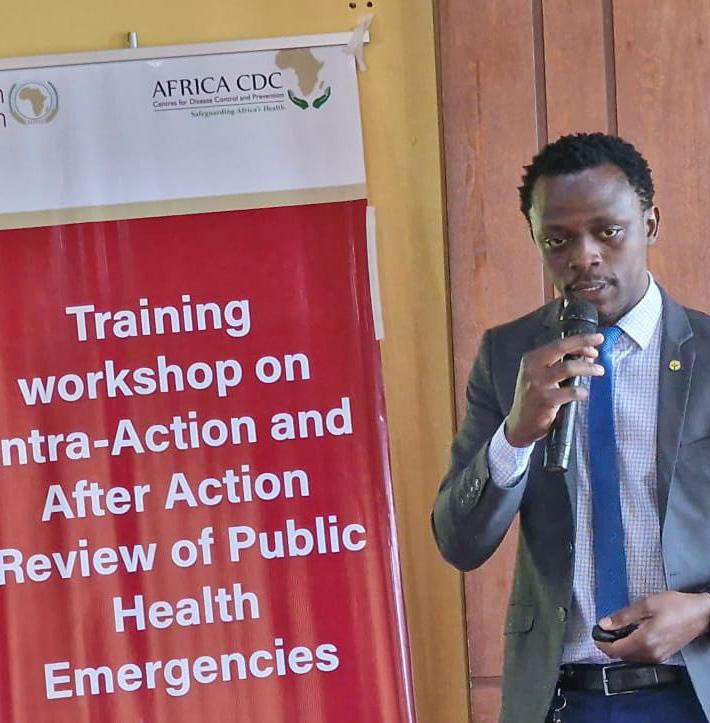
continuum, especially in addressing the preparedness needs in fragile, conflict and vulnerable settings and the necessary integration of health security preparedness within the humanitarian-developmentpeace nexus.
The department also works closely with WHO Regional and Country Offices and relevant HQ teams at the interface between medium to longerterm emergency preparedness and its foundation towards readiness for imminent hazards, high-threat pathogens and pandemic management. In addition, the HSP department supports health systems building and strengthening for Member States to meet the demands imposed by health emergencies while deepening engagement to strengthen global architecture for Health Emergency Preparedness, Response and Resilience (HEPR).
Beyond WHO, the department engages, collaborates and coordinates with existing and new donors and partners that provide expertise and resources for the country's implementation of activities for
strengthening preparedness and response capacities. This includes the WHO Global Strategic Preparedness Network (GSPN) and Strategic Partnership Portal for Health Security (SPH). The Portal, available via https://extranet.who. int/sph/ is an interactive digital platform for the global sharing and exchanging of multisectoral health security information.
Additionally, the department, through the Human-Animal Interface (HAI) team, was successful in developing, piloting and implementing its tools and programmes in close collaboration with the Food and Agriculture Organization of the United Nations (FAO) and the World Organisation for Animal Health (WOAH). With the integration of the United Nations Environment Programme (UNEP) in the Tripartite partnership (now named Quadripartite - QPT) and through the discussions for the finalization of the QPT Joint Plan of Action, the collaboration with UNEP is developing. Integration of UNEP provides opportunities for strengthening health security by including the environmental sector.
The department pursued partnerships within the organization and with external donors and partners for various projects and activities, including the U.S. Centers for Disease Control and Prevention (CDC), Africa CDC, the West African Health Organizations (WAHO)
and the Economic Community of West African States (ECOWAS), Robert Koch Institute and UK Health Security Agency (UKHSA), especially for SimEx activities.
This is in addition to the immense support and engagement with several collaborating centres such as Public Health England, CDC Atlanta, Netherlands National Institute for Public Health and the Environment (RIVM) and the Japan Disease Control and Prevention Center, National Center for Global Health and Medicine Hospital.
In the year, there has been continued interest and advocacy by external partners for integrating gender within health emergency preparedness and response frameworks. Notably, the firstever strategy for Mainstreaming Gender within the WHO Health Emergencies (WHE) Programme was launched, covering five years. The strategy seeks to ensure WHE policies, programmes and practices are responsive to the specific needs of all gender identities, particularly the most vulnerable and discriminated against, throughout the health emergency cycle. In addition, the WHE Gender Working Group is involved in the research on gender and health security, and the development of a new online course on sex, gender and infectious disease programmes (in progress) is chaired by the
HSP Director, who oversees its implementation.
Urbanization is critical and sets to continue and accelerate. This requires a unique and contextualized response from an emergency preparedness perspective, outlined in the World Health Assembly Resolution 75.7 on Urban Health Emergency Preparedness and Response.


Top: Meeting to update the Universal Health and Preparedness Review (UHPR) documents in Geneva, Switzerland.
Bottom: Member States briefing on Universal Health & Preparedness Review pilots in the Central African Republic, Iraq, Portugal, and Thailand at the WHO HQ.
Note:
Country COVID-19 intra-action review (IAR): Since 2020, 138 IARs completed in 78 countries; 12 were conducted in 2022.
National Action Plan for Health Security (NAPHS) Workshops: Since 2016, 87 workshops have been done; 12 were in 2022.
Joint External Evaluations (JEEs): Since 2016, 117 countries have completed JEEs; four countries completed in 2022.
Simulation exercises (SimEx): Since 2016, 195 exercises have been done; 22 were in 2022.
After Action Reviews (AARs): Since 2016, 76 AARs have been completed; eight were in 2022.
IHR-PVS National Bridging Workshops (NBWs): Since 2017, 44 NBWs have been conducted; of these, eight were in 2022.
Joint Risk Assessment (JRAs): Since 2018, 37 JRAs have been completed; three were in 2022.
Strategic Risk Assessments (STAR): Since 2016, 93 STAR workshops have been conducted; 15 were in 2022.
For additional information on the calendar of missions and activities, please check out the Strategic Partnership Portal for Health Security (SPH) available here: https://extranet.who.int/sph/
Five-year Strategy for Mainstreaming Gender within the WHO Health Emergencies Programme launched.
High-level meetings to validate the Universal Health Preparedness Review (UHPR)
National Report of the Central African Republic.
Flagship document for urban health emergency preparedness - the Framework for Strengthening Health Emergency Preparedness in Cities and Urban Settings launched.
Webinar: Using IHR data with health systems, socioeconomic and population data in collaboration with the Institute for Health Metrics and Evaluation (IHME)
Two workshops conducted by EURO on National health emergency response plan development and health facility preparedness and hospital response planning in the West Balkan Region
Universal Health Preparedness Review (UHPR) pilot in Iraq
The WHO guidance on urban preparedness for national and local authorities was launched.
Launch of the “Introduction to IHR Monitoring and Evaluation” online course.
The Gender Working Group co-organized, jointly with the WHE Learning and Capacity Development Unit, a celebration of International Women’s day: Celebrating Women in Leadership: A conversation about challenges, enablers, and opportunities for women working in health emergencies.
Third meeting of the UHPR Technical Advisory Group (TAG)
Joint WHO-IPU handbook for parliamentarians “Strengthening Health Security: The International Health Regulations (2005) published.
Launched the WOAH Performance of Veterinary Services (PVS) Pathway module in partnership with the World Organisation for Animal Health (WOAH), on the SPH Portal.
HSP Department staff from the Disaster Risk Management and Reduction unit deployed for the emergency response to Ukraine for three weeks.
Universal Health Preparedness Review (UHPR) pilot in Thailand
WHO co-hosted with UN-Habitat and UNECE the event Urban Pandemic Preparedness: City contributions to international processes on pandemic prevention, preparedness and response.
Revision of the draft health security civil-military mapping tool.
Session on COVID-19 whole-of-society recovery priorities for health system strengthening following a risk management approach at World Reconstruction Conference 5 in Indonesia
Universal Health Preparedness Review (UHPR) pilot in Portugal
Retreat by Universal Health Preparedness Review (UHPR) Secretariat in HQ to discuss the lessons learned from the first round of UHPR pilots
Concept note on the Universal Health and Preparedness Review (UHPR) presented at the 75th World Health Assembly
WHO Member States adopt at the 75th World Health Assembly landmark Resolution on Strengthening Health Emergency Preparedness and Response in Cities and Urban Settings.
7th Meeting of the United Nations Senior Leadership Group for Disaster Risk Reduction for Resilience (UNSLG)
Supported PAHO in a virtual webinar about Resilient Health Systems and Services in the context of emergencies and disasters from policy to practice.
Technical support for STAR workshop at the Nigeria Centre for Disease Control (NCDC)
Two oral presentations and four posters at the Global Health Security Conference in Singapore
Annual meeting of the UN Senior Leadership Group on Disaster Risk Reduction for Resilience (UNSLG)
Global Health Security Conference, where WHO collaborating with the government of Finland, held a plenary session on Gender and Health Security.
Fourth meeting of the Universal Health Preparedness Review (UHPR) TAG
Presentation on civil-military collaboration for strengthening health emergency preparedness during WHE Town Hall.
Global STAR Master Training in Cairo, Egypt, to review the STAR process steps from the newly published guidance, best practices from country experiences and facilitation.
Presentation on the progress of the work of the Inter-Negotiation Body (INB) related to the new pandemic accord, linkages to the IHR Review Committee and implications for parliamentarians.
Keynote speech by Dr Stella Chungong, Director, HSP, at the opening of the International Committee of Military Medicine (ICMM) World Congress 2022 in Brussels, Belgium.
Training of Trainers and pilot of locally adapted health facility safety and resilience toolkit in Cox Bazar, Bangladesh.
EURO/Balkans and Caucasus STAR Training in Istanbul, Turkiye targeting the countries and territory that fall under the Balkans Hub and the Caucasus Hub (Albania, Armenia, Azerbaijan, Bosnia and Herzegovina, Georgia, Moldova, Montenegro, North Macedonia, Kosovo and Serbia).
HSP department commissions report, to be launched in 2023, to collect evidence of the relevance of gender for health security and will collect stories about the role of gender in surveillance, provision of health services, and the health workforce, among others.
Support for the CADRI Tool for Capacity Diagnosis and Planning on whole of society capacities for Disaster Risk Reduction in Tanzania.
First pilot induction session on Gender and Health Emergencies organized for the Türkiye Country Office staff.
Technical support for AFRO in the development of the concept note for the first African Parliamentarian Forum on Health Security.
Implemented the revamped JEE Roster of Experts module under SPH Portal with JEE Thailand as the first mission and followed by Nepal.
Conducted a rapid qualitative review of governance for health systems and applied it to Sierra Leone and the Central African Republic in support of the development of the UHPR for governance.”
Eastern and Southern Africa Hub training workshop in Rwanda to certify STAR facilitators within the region.
Third Annual Internal WHO Meeting of DRR Focal Points to discuss advancements and challenges of HEDRM risk management implementation
The WHE Gender Working Group makes presentation at the United Nations Institute for Disarmament Research (UNIDR) during the 2022 Biological Weapons Convention Meeting of State Parties.
Supported Namibia Country office to develop a protocol to document experiences and lessons learnt when conducting Simulation Exercises during the response to COVID-19
Member States information session on the UHPR
Presentation during the session on “Strengthening the role of parliaments in health emergency preparedness” at the IPU Second Regional Seminar for African Parliaments on Achieving the Sustainable Development Goals in Dijbouti
Costing and investment cas support for NAPHS mission to Central African Republic.
For additional information, check out the Strategic Partnership Portal for Health Security (SPH) available here: https://extranet.who.int/sph/

1. Clarke L, Patouillard E, Mirelman AJ, Ho ZJM, Edejer TT, Kandel N. The costs of improving health emergency preparedness: A systematic review and analysis of multi-country studies. EClinicalMedicine. 2022 Jan 27;44:101269. doi: 10.1016/j.eclinm.2021.101269.
2. Belot, G., Caya, F., Errecaborde, K.M., Traore, T., Lafia, B., Skrypnyk, A., Montabord, D., Carron, M., Corning, S., Sreedharan, R., Isla, N., Schmidt, T., Gongal, G., Samhouri, D., Perez-Gutierrez, E., Riviere-Cinnamond, A., Xing, J., Chungong, S. & de la Rocque, S. 2021. IHR-PVS National Bridging Workshops, a tool to operationalize the collaboration between human and animal health while advancing sector-specific goals in countries. PLoS ONE 16(6): e0245312. https://doi. org/10.1371/journal.pone.0245312.
3. Brown GW, Bridge G, Martini J, Um J, Williams OD, Choupe LBT, Rhodes N, Ho ZJM, Chungong S, Kandel N. The role of health systems for health security: a scoping review revealing the need for improved conceptual and practical linkages. Global Health. 2022 May 15;18(1):51. doi: 10.1186/ s12992-022-00840-6.
4. de la Rocque, S., Belot, G., Errecaborde, K.M., Sreedharan, R., Skrypnyk, A., Schmidt, T., Isla, N., Traore, T., Talisuna, A., Gongal, G., Samhouri, D., Caya, F., Carin, M. Kandel, N., Xing, J.& Chungong, S. 2021. Operationalisation of consensual One Health roadmaps in countries for improved IHR capacities and health security. BMJ Global Health Jul; 6(7):e005275. doi: 10.1136/ bmjgh-2021-005275
5. de La Rocque,S., K. Myhre Errecaborde, G. Belot, T. Brand1 S. Shadomy, S. von Dobschuetz, R. Aguanno, M. Carron, F. Caya, S. Ding, M. Dhingra, D. Donachie, G. Gongal, P. Hoejskov, G. Ismayilova, G. Lamielle, H. Mahrous, Mariana Marrana, S. Nzietchueng, Y. Oh, J. Pinto, X. Roche, A. Riviere- Cinnamond, C. Rojo, L. Scheuermann, J.Sinclair, J. Song, A. Skrypnyk, T. Traore, K. Wongsathapornchai. 2023. One Health Systems Strengthening in Countries: Tripartite tools and approaches at the humananimal-environmental interface. In press in BMJ Global health; 8:e011236. doi:10.1136/ bmjgh-2022-011236
5. Errecaborde, K.M., Belot, G., Traore, T., Skrypnyk, A. Gongal, G. & de La Rocque, S. 2021. Paving the path for health security and emergency preparedness by pairing national One Health road maps with multisectoral implementation tools and approaches. Weekly Epidemiological Record, 96:27-31. doi:https://apps.who.int/iris/ handle/10665/345531
6. Francesca Gorla, Anna Silenzi, Anja Borojevic, Chiara Gibertoni, Luca Lavazza, Luisa Scardovi, Barbara Burmen, Jetri Regmib and Luca Fontanaa. 2021. “The hospital of tomorrow’’: a participative, holistic method to innovate healthcare facilities during the COVID-19 pandemic, 2020–2021 (who.int)
7. Fossouo Ndoungue, V., Bello, D., Feussom Kameni, J.M., Damou Lamtoing, A., Douba Epee, C.E., Abdou, S., Mouiche Mouliom, M.M., Njajou, O.T., Traoré, T., Wango, R.K., Belot, G.,

Agbo Kouadio, S. & de La Rocque, S. IHR-PVS
National Bridging Workshop in Cameroon: an interactive and participatory approach to engage stakeholders in the development of a One Health road map. Submitted to One Health
8. Health Security Planning: Developing the Cameroon National Action Plan for Health Security | Health Security (liebertpub.com)
9. Kandel N, Chungong S; WHO Technical Working Group of the Dynamic Preparedness Metric and Health Security Preparedness Department. Dynamic preparedness metric: a paradigm shift to measure and act on preparedness. Lancet Glob Health. 2022 May;10(5):e615-e616. doi: 10.1016/ S2214-109X(22)00097-3.
10. Kandel, N. Chungong, S. et al. 2022. Dynamic preparedness metric: a paradigm shift to measure and act on preparedness. The Lancet Global Health 10(5): E615-E616. doi: https://doi. org/10.1016/S2214-109X(22)00097-3
11. World Health Organization. (2020). Multisectoral preparedness coordination framework: best practices, case studies and key elements of advancing multisectoral coordination for health emergency preparedness and health security. World Health Organization. https://apps.who.int/ iris/handle/10665/332220
12. Zinsstag, J., Kaiser-Grolimund, A., Heitz-Tokpa, K., Sreedharan, R., Lubroth, J., Caya, F., Stone, M., Brown, H., Bonfoh, B., Dobell, E., Morgan, D.,
Homaira, N., Kock, R., Hattendorf, J., Crump, L., Mauti, S., del Rio Vilas, V., Saikat, S., Dar, O., de la Rocque, S. 2023. One Health for global health security: What does the evidence say?. The Lancet. – doi: 10.1016/S0140-6736(22)01595-1
1. Manuscript in preparation for submission to the BMJ Global Health (Article type: Practice) titled “Lessons learned on countries’ COVID-19 vaccine roll-out – sharing through a global community platform.”
2. Manuscript in preparation for submission to the Lancet Global Health (Article type: Health Policy Paper) titled “Reflecting on COVID-19 intra- action reviews – the importance of institutionalizing collective introspection during and after public health emergencies.”
3. Njenge, H., Copper, F., Bell, A., Charles, D. Wesonga, T. Nyongesa Wakhungu, J., Katende, M., Komba, E.A., Nandako Nafula Kituyi, P., Mmbaga, V., Nguvila, T. Makata, M.A., Chinyuka, H. de La Rocque, S., Sreedharan, R., Stephen, M., Saguti, G.E.B, Ganda, N. and coll. 2021. Strengthening emergency preparedness and response capacities for zoonotic diseases outbreaks in East Africa through a multi-sectoral cross-border field simulation exercise at Namanga One Stop Border Post: Lessons Learned. Health Security Journal , Submitted.

1. “Exercise Cinnamon – Exercise report on the Internal WHO Radiation/Nuclear Exercise.”
2. “Qatar SimEx Programme: Summary Debrief report – Operation Health Check 3.”
3. “A global analysis of COVID-19 intra-action reviews: reflecting on, adjusting and improving country emergency preparedness and response during a pandemic” (Estimated publication date: December 2022)
4. “Ukraine Crisis Review for the BSP unit and IMST “technological and environmental hazards” sub pillar FINAL REPORT HQ Geneva, 4 - 5 July 2022.”
5. “After Action Review 2021 FIFA Arab Cup, Doha, Qatar – 24 March 2022.”
6. Sendai Framework (2015 – 2030), Mid-Term review provided to UNDRR.
7. Progress Report on the United Nations Plan of Action, summarizing WHO DRR initiatives in 2020 emphasizing operational activities, including gender, equity, and empowerment as collective actions towards the 2025 targets of alignment with the principles that are driving broader UN contribution to implementation of the 2030 Agenda for Sustainable Development.
8. Health Systems for Health Security Framework: https://apps.who.int/iris/handle/10665/342006
9. Multisectoral Coordination Mechanisms Operational tool publication: https://apps.who.int/iris/ handle/10665/359001
10. Surveillance and Information Sharing Operational Tool publication https://apps.who.int/iris/bitstream/hand le/10665/361443/9789240053250-eng.pdf
11. Mainstreaming gender within the WHO Health Emergencies Programme: 2022–2026 strategy https://apps.who.int/ iris/bitstream/handle/10665/360406/9789240049291-eng.pdf
12. Joint External Evaluation third edition: https://www.who.int/publications/i/item/9789240051980
13. WHO-IPU handbook for parliamentarians “Strengthening Health Security: the International Health Regulations (2005)” at the Asian Pacific Parliamentary Forum for Global Health (APPFGH) in Seoul, ROK.
14. Tunisia REMAP workshop Report: https://extranet.who.int/sph/sites/default/files/remap/Tunisia%20REMAP%20 Workshop.pdf
15. Gambia REMAP workshop Report https://extranet.who.int/sph/sites/default/files/remap/The%20Gambia%20 REMAP%20Workshop%20Report.pdf
16. Framework for strengthening health emergency preparedness in cities and urban settings (who.int) https://apps. who.int/iris/handle/10665/348351
17. Strengthening health emergency preparedness in cities and urban settings: guidance for national and local authorities (who.int) https://apps.who.int/iris/handle/10665/351721

Rights-based Global Health Security through all-hazard risk management, in press. The chapter covers the broader all-hazards, whole-of-society risk management aspects of preparedness for epidemic, pandemic and concurrent emergencies which are key to global health security and attaining sustainable development. Authors: Qudsia Huda[1](Chapter lead), Dr Erin L. Downey[2](Corresponding author), Dr Ali Ardalan[3], Dr Shuhei Nomura[4], Dr Ankur Rakesh[5](Concluding author)
The International Response to Animal Health and Climate Change (13 pages) in the book entitled ‘Climate Change and Animal Health’. First Edition, published in 2022. eBook ISBN9781003149774. Authors: Maud Carron, Tianna Brand, Sophie Muset, Keith Hamilton, Chadia Wannous, François Diaz, Guillaume Belot, Stéphane de la Rocque, Julio Pinto, Delia Grace Randolph, Ahmed. H. El Idrissi.
[1] WHO Headquarters, World Health Organization, Geneva, Switzerland
[2] Harvard Humanitarian Initiative, Harvard T.H. Chan School of Public Health Cambridge, United States [3] WHO Regional Office for the Eastern Mediterranean, World Health Organization, Cairo, Egypt
[4] Department of Health Policy and Management, School of Medicine, Keio University, Tokyo, Japan
[5] WHO Headquarters, World Health Organization, Geneva, Switzerland
COVID-19 vaccination intra-action reviews – Countries share COVID-19 vaccine roll-out learnings through a global community forum: https://bit.ly/3FAnkzj
WHO supports After Action Review of the 9th, 10th, 11th and 12th Ebola outbreak in the Democratic Republic of Congo to identify lessons to better respond to future outbreaks: https://www.who.int/about/accountability/ results/who-results-report-2020-2021/country- story/2021/democratic-republic-of-congo






























ABOAGYE, Ernest; ABRAHAMS, Jonathan; Bismarck Owusu; BURMEN, Barbara; BARGORIA, Jeruto; BAYUGO, Yolanda; BELL, Allan; BELL, Cynthia; BELOT, Guillaume; BIEH, Kingsley Lezor; BODMER, Louis Azad; CHARLES, Denis; CHIU DE VAZQUEZ, Cindy; CHRETIN-GUETTE, Leslie; CHUNGONG, Stella; CLARKE, Lorcan; COCKERHAM, Sean; COPPER, Frederik Anton; DE LA ROCQUE DE SEVERAC, Stéphane; DACEY, Gillian; DING, Shanlong; Erin L. DOWNEY; ERRECABORDE, Kaylee; GRIBBLE, Rebecca; HARROP, Lynne; HUDA, Dr. Qudsia; JAMALUDIN, Mohd Shahrir; JOHNSON, Ebenezer Kojo; JONNALAGEDDA, Mahathi; KANDEL, Nirmal; KILONZO, Eunice Kalunde; LAPITAN, Jostacio M.; Liviu Vedrasco; CLARKE, Lorcan; MALA, Peter Omondi; MAYIGANE, Landry Ndriko; MBANYA, Armand Ngassa; MEKURIA, Elias; MORTAROTTI, Alberto; NGUNI, Robert ; NGUYEN Nam; NUSR, Rasha Bushra; PORTORICO, Mariaisabella; PRASARNPHANICH, Ongorn; RANASINGHE, Priyanga; REYNAUD, Mauricio; RODRIGUEZ RIBAS, Clara; SARMIENTO, Nap Don; SCHEUERMANN, Lisa; SEMBIRING, Miftahul Fahmi; SREEDHARAN, Rajesh; STELTER, Romina; SURYANTORO, Ludy Prapancha; TABUKE, Lydia Kathleen; TEWOLDE, Elleanie; NGUYEN Nam; THAMRIN, Barnas; TILIOUINE, Adam; TSACHOUA CHOUPE, Luc Bertrand; VELLA, Cécile; VENTE, Candice; VERBOOM, Paul; VERNACCINI, Luca; VON HARBOU, Kai; WARREN, Kathleen (Taylor); XING, Jun; and YU, Lina.


























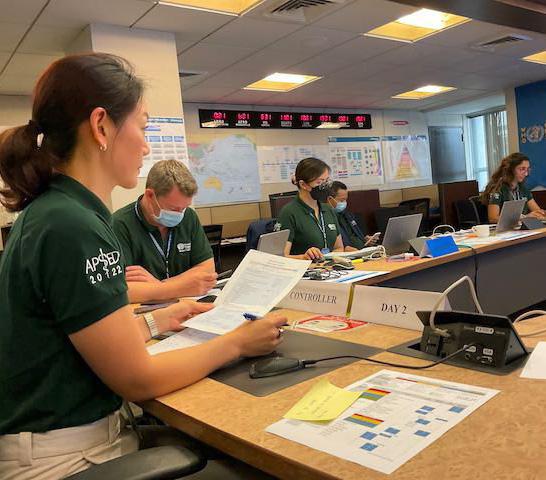
1 Training of facilitators in Rwanda on the Strategic Toolkit for Assessing Risk (STAR)— vital to strengthen health systems & for better response to outbreaks in the East/ Southern Africa regions.
2 About 120 participants attended a workshop to develop a 2-year costed multi-sectoral National Action Plan for Health Security and map out risks, gaps, resources & draft investment cases to implement NAPHS. The Central African Republic’s Ministry of Health and Population & CAR’s World Health Organization office organised the workshop.
3 Multi-sectoral HSP workshop to support South Africa's Ministry of Health in developing the National Health Emergency Response Operations Plan that will ensure rapid response & effective nationwide coordination during health emergencies.
4 WHO Regional Office for Africa organised the training on health emergency management practices, including the use of Simulation Exercises, Intra & After Action Reviews. The training brought together 160 participants from Anglophone & Francophone countries.
5 The WHO in the Western Pacific Region hosts a successful annual Exercise Crystal where 26 countries tested & practised reporting public health events. Three Member States ran an extended Crystal+, using a whole-of-government approach, the role of IHR National Focal Persons and other functions.


6 Thailand is the 1st country to do the JEE 3rd edition, which includes COVID-19 lessons; the 1st to do a 2nd round of the JEE; & the 1st to use the JEE web platform. In 2022 Thailand was the 1st SEAR country to conduct the UHPR.
7 WHO Regional Office for Europe hosted a global training for experts from all WHO regional offices on the Strategic Toolkit for Assessing Risk (STAR), vital for pandemic preparedness, readiness & response, including in humanitarian settings & SIDs in Cairo, Egypt.
8 Joint External Evaluation with 18 experts & Nepal’s national team evaluating the country’s capacities to prevent, detect & respond to public health risks. This is the 118th JEE & 2nd country to use the 3rd edition of JEE.
9 The 7th Global Health Security Agenda (#GHSA) Ministerial Meeting in Seoul, South Korea.
10 The 44th International Committee of Military Medicine (ICMM) World Congress in Brussels, Belgium.
11 PAHO/WHO Regional Meeting to review International Health Regulations indicators and share experiences from COVID-19 in Santiago, Chile.



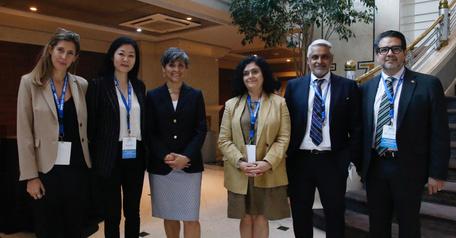
Africa CDC
Africa Europe Foundation
African Development Bank
African Risk Capacity
All WHO Member States
Asia Europe Foundation
Capacity for Disaster Reduction Initiative (CADRI)
Partnership
China CDC
European Centre for Disease Prevention and Control (ECDC)
Economic Community of West African States (ECOWAS)
European Commission
Food and Agriculture Organization of the United Nations (FAO)
George Town University
Global Health Security Agenda (GHSA)
GIZ
Global Fund
Group of Friends of the Universal Health and Preparedness Review (UHPR)
International Atomic Energy Agency (IAEA)
International Association of National Public Health Institutes (IANPHI)
International Committee of Military Medicine (ICMM)
International Committee of the Red Cross (ICRC)
International Federation of Red Cross and Red Crescent Societies
Institute for Health Metrics and Evaluation (IHME)
Infectious Disease Institute Uganda
Infrastructure Development Collaboration
Partnership Fund (DevCo)
Institut National de Santé Publique - Burkina Faso
International Federation of Biosafety Associations
International Organization for Migration (IOM)
Inter-Parliamentary Union
International Telecommunication Union (ITU)
Jameel Institute for Disease and Emergency Analytics, Imperial College London
Japan International Cooperation Agency (JICA)
John Hopkins University
Korea International Cooperation Agency
Kwame Nkrumah University of Science and Technology
Makerere University, School of Public Health
United Nations Office for the Coordination of Humanitarian Affairs
Private Sector Roundtable (PSRT) for Global Health Security
Qlik.org
Resolve to Save Lives
Robert Koch Institute
Russian Fund
SafetyNet
Swiss Philanthropy Foundation
U.S. Defense Threat Reduction Agency (DTRA)
Universal Health and Preparedness Review (UHPR)
Technical Advisory Group
UK Health Security Agency (UKHSA)
UN Habitat
UN Resident Coordinators
UNAIDS
United Nations Office for Disaster Risk Reduction (UNDRR)
United Nations Economic Commission for Europe
UNICEF
United Nations Environment Programme (UNEP)
University of Leeds
University of New Mexico (ECHO project)
US-CDC
West African Health Organizations (WAHO)
World Bank
World Bank Group
World Health Organization (WHO)
World Organization for Animal Health (WOAH)
Continue generating evidence-based solutions for sustainable and adaptable health emergency preparedness
Support countries to adapt key lessons from recent health emergencies to help mitigate the impact of future distasters through investing sufficiently in preparedness
Health Security Preparedness
Support countries in strengthening their health emergency preparedness capacities through leveraged partnerships at the global, regional and global levels
Health Security Preparedness Department
World Health Organization 20 Avenue Appia 1211 Geneva 27
Switzerland who.int
WHO/WPE/HSP/2023.1 – © WHO 2023. Some rights reserved. This work is available under the CC BY-NC-SA 3.0 IGO licence.